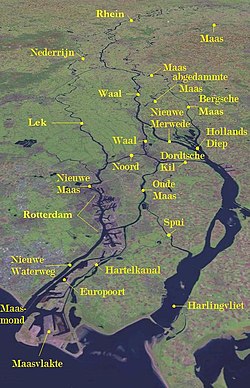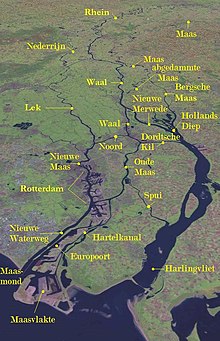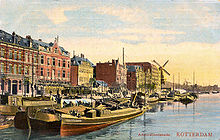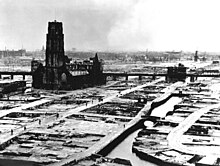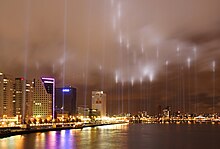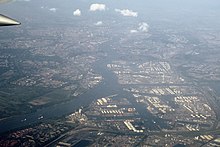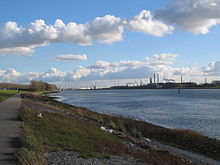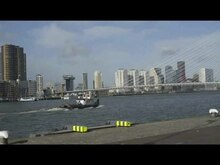Rotterdam
 flag |
 coat of arms |
| province |
|
| mayor | Ahmed Aboutaleb ( PvdA ) |
| Seat of the municipality | Rotterdam |
|
Area - land - water |
324.16 km 2 215.64 km 2 108.52 km 2 |
| CBS code | 0599 |
| Residents | 645,965 (Jan 31, 2019) |
| Population density | 1993 inhabitants / km 2 |
| Coordinates | 51 ° 56 ′ N , 4 ° 29 ′ E |
| Important traffic route |
|
| prefix | 010 |
| Postcodes | 3001-3009, 3011-3016, 3021-3029, 3031-3039, 3041-3047, 3051-3056, 3059, 3061-3069, 3071-3079, 3081-3089, 3151, 3181, 3191-3199 |
| Website | Homepage of Rotterdam |
| Rhine-Maas Delta | |
With 645,965 inhabitants (as of January 31, 2019), Rotterdam is the second largest city in the Netherlands after Amsterdam . Due to the largest seaport in Europe, it is an important hub for freight traffic. In addition to Amsterdam and The Hague , Rotterdam is also one of the cultural centers of the Netherlands. Rotterdam has a traditional university , several technical colleges , a music academy and an art academy . It is the leading industrial and commercial city in the Netherlands. The Rotterdam skyscraper silhouette , which has been developing since the mid-1980s, is striking .
geography
Rotterdam is located in the western Netherlands in the province of South Holland at the confluence of the Rhine with the North Sea ( Rhine-Maas Delta ) and belongs to the Randstad agglomeration . The closer urban region of Rotterdam includes large neighboring cities such as Schiedam , Vlaardingen and Dordrecht .
Most of Rotterdam is below sea level and protected by dikes . The Prins Alexander Polder is about six meters below the Amsterdam level . The lowest inhabited point in the Netherlands with -6 m NAP is in the city of Rotterdam, the lowest point in the Netherlands (including the uninhabited areas) with -6.74 m NAP is just east of the city limits in Nieuwerkerk aan den IJssel . The highest point of the city is about six meters above the adjacent polders , but also only two meters above sea level. Rotterdam has to be constantly drained by pumps, as the natural groundwater level would otherwise be above street level.
The river Nieuwe Maas , a main arm of the Rhine Delta , divides the city into a northern and a southern part. Contrary to what the name of the river suggests, the Nieuwe Maas is an arm of the Rhine. Since the last shift from the Rhine and Maas to the south, hardly any Maas water has flowed in it. The actual city center is on the north bank of the river; the southern part of the city is characterized by the port and the former dockworkers' settlements. It was only in the last few decades that the center began to expand to the districts on the southern bank, especially the De Kop van Zuid (“head of the south” - the northernmost part of the southern bank).
The Nieuwe Maas is crossed by several bridges and tunnels. These are from west to east (upstream):
- Benelux tunnel
- Meuse tunnel
- Erasmusbrug
- Subway tunnel
- Willemsspoortunnel
- Willemsbrug
- Van Brienenoordbrug
The Rotte river, which gives the city its name , no longer flows into the Nieuwe Maas. Since the construction of the second underground line in the 1980s, it has been pumped into the river through a pipeline, otherwise problems with the route design would have arisen.
Between the actual urban area and the North Sea, along the Nieuwe Maas and the Nieuwe Waterweg, lies the city's extensive port area, which extends to Hoek van Holland .
Rotterdam has eleven sub-municipalities : Charlois (including Heijplaat), Delfshaven , Feijenoord , Hillegersberg- Schiebroek, Hoek van Holland , Hoogvliet , IJsselmonde , Kralingen-Crooswijk , Noord , Overschie and Prins Alexander (the most populous district with 85,000 inhabitants). Two other districts, Centrum and Pernis , do not have the status of an official district.
history
Between its founding in the 13th century and the end of the 19th century
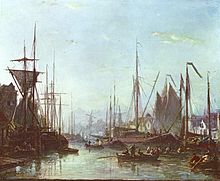

Rotterdam was founded in 1230 when a dam was built on the Rotte River. The first settlers were probably herring fishermen who reloaded their catch here. After receiving city rights in 1340, the city quickly developed into a rich trading city due to its favorable geographical location. The first city fortifications date back to 1359. During the war with Spain in the 1570s, Rotterdam was one of the few port cities with free access to the sea.
The port continued to grow, but the defining point in time for the development to become the largest port in Europe was the construction of the Nieuwe Waterweg in 1853. This created a lock-free open canal to the North Sea and Rotterdam became the most important import and export port for the rapidly expanding industry in the Ruhr area upstream . At that time, city politics were shaped almost exclusively by traders, in the city council this group made up over 90% of the members until 1880, whereby the dynasties Mees, Stolk and Van Oordt were influential.
The port and economy ensure an enormous boom from the 20th century
First the city with the district Feijenoord expanded to the south side of the Nieuwe Maas , then followed Rijnhaven , which destroyed large parts of the old village Katendrecht (1894), Maashaven (1905), which opened a completely new dimension for large docks in Rotterdam, the Waalhaven in 1919 for coal, ore and grain, 1923 Merwehafen, 1929, the first oil port, the 1936 was followed by the settlement of the first refinery, and in 1938 the second oil port. In the years between 1869 and 1913 the population quadrupled from 116,000 to 462,000.
In addition to the better connection to the North Sea, the economic upswing in Germany and, above all, the Ruhr area also made Rotterdam a center of European industry. While the city was on the edge of the prosperity zone during the industrial revolution, it began to lie in the middle of the Great Britain-Ruhr area trade route since the early days , and also at the strategically important transition from sea to river and rail traffic.
Destruction in World War II and reconstruction
During the Second World War , the city center of Rotterdam was almost completely destroyed in the German air raid on May 14, 1940 and the subsequent fires. Around 800 people died and 80,000 Rotterdamers were made homeless. In the urban area, 260 hectares of dense development were destroyed; it contained 25,000 apartments, 70 schools, 2,400 shops and 2,000 offices. Only the more massive buildings of the town hall, post office, stock exchange and St. Laurentius Church remained, even if they were badly damaged. After the German occupation of the city, the foundation walls were "placed under art protection by order of the Führer". Further smaller air raids, this time by the Allies, followed in October 1942 and March 31, 1943, before the Germans again destroyed large parts of the port facilities in 1944. The port also suffered from the attack, which destroyed 35% of the quay walls, 45% of the handling capacity and 40% of the storage rooms.
The air force attack is still deeply rooted in the memory of the people of Rotterdam. The old Rotterdam largely disappeared and was rebuilt in a modern way. After the reconstruction, the port was one of the most modern in Europe and continued to expand. Shortly thereafter, the next oil port followed with the Botlek project, whose industrial areas were completely filled just nine months after completion. It was not until the mammoth project of Europoort , a 15 kilometer long port that had to give way to two villages and a nature reserve, that the desired areas were created for the chemical industry, which settled in Rotterdam.
In 1962, the city replaced New York as the largest port in the world with an annual turnover of 92 million tons . In 1967 the first transatlantic container ship landed in the port, and the city and its port continued to expand.
The Maasvlakte was heaped on a sandbank from 1970 to 1985, the area in the port area increased from 3000 to 10,000 hectares.
The University of Rotterdam was founded in 1972 after Rotterdam was one of the largest western cities without a university. In 1985 port operations were largely outsourced to areas on the Nieuwe Waterweg and the Maasvlakte off Rotterdam. New concepts for integration into the cityscape are being sought for the port areas close to the center, such as the Kop van Zuid .
population
Origin, age, income
The population of Rotterdam is mixed in terms of origin and cultural background. Rotterdam is the only city in the Netherlands where the average age of the population has decreased since 2000. The main reason for this is immigration from Turkey , Morocco and Suriname .
On January 1, 2009, Rotterdam became the first city in the Netherlands to receive a mayor of Moroccan descent with two nationalities, the Dutch State Secretary for Social Affairs, Ahmed Aboutaleb ( PvdA ).
Officially, only a little more than half of the residents are without a migrant background (in the Netherlands this is called autochthonous ). The largest allochthonous population groups are immigrants from the former Dutch colonies (mainly from Suriname and the Netherlands Antilles ) as well as guest workers from Turkey, Morocco and Cape Verde (figures from December 1, 2005: total population: 589,156, autochthonous 318,672, Surinamese 52,377, Turks 40,820, Moroccans 34,281, Antillians / Arubans 20,390, European countries bordering the Mediterranean 18,127, Cape Verdeans 14,919, other allochtones 97,543).
Around 6000 Rotterdam residents are of German or German descent. Many of them came either as guest workers (after the Second World War and in the 1990s when the Netherlands was looking for a large number of workers) or as students to study at one of Rotterdam's universities.
While the average income of residents in the urban area is lower than in the rest of the Netherlands, it is higher in the suburbs. In the city itself, however, around ten percent of residents receive benefits from the social welfare office (compared with around three percent in the whole of the Netherlands) and even in the group of 15 to 34 year olds the proportion is eight percent.
Population development
Rotterdam expanded particularly in the late 19th and early 20th centuries when the city rose to become Europe's most important industrial port. Between 1900 and 1930 alone, the population rose from 318,000 to 580,000, with corresponding problems for town planning.
The city has been dealing with immigration from non-EU countries since the 1970s. Unrest in the Afrikaanderwijk district and recurring scandals in the accommodation of guest workers prompted the city administration to deal with the issue. A migration authority has existed since 1972, and in 1978 the first official plan followed with the Memorandum on Migrants in Rotterdam (Nota Migranten in Rotterdam) . With this and later projects, the Rotterdam city administration has always pursued a policy of strong integration, if not assimilation. Special arrangements and facilities for migrants should be avoided.
The city of Rotterdam is forecasting an increase in the allochthonous population to 57.2% in 2017. Not included in this figure is the third generation, which will make up around 3.3% in 2017.
Demographic development
| year | 2010 | 2011 | 2012 | 2013 | 2014 | 2015 | 2016 | 2017 | 2018 | 2019 | 2020 |
|---|---|---|---|---|---|---|---|---|---|---|---|
| Residents | 592.939 | 610.412 | 616.456 | 616.319 | 618.109 | 623.967 | 629.148 | 634.264 | 638.181 | 644.373 | 650,597 |
Economy and Transport
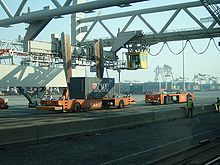
Economic structure
The decisive economic factor of Rotterdam is the port , the hinterland of which is not only considered to be the Netherlands, but also large parts of Germany and parts of Western Europe. Large companies account for a large part of the economic power outside the direct port. 2% of the companies alone employ over 50% of the workforce in the city.
Overall, Rotterdam's economy is focused on sectors that have lost jobs in all industrialized countries in recent years: transport, logistics and industry. At 67,000 euros per year, earnings per worker are well above the national average (The Hague, for example, 62,000 euros, Amsterdam 58,000 euros), which is mainly due to the extremely capital-intensive petrochemical industry that has settled in the port area.
The unemployment rate has been well above the Dutch average in recent years, with a difference of three to five percentage points. Rotterdam has the highest unemployment rate in the Randstad . The workers are much younger than in the rest of the Netherlands; in Rotterdam, 47% of employees are under 35 years of age, compared with 39% national average.
Infrastructure and traffic
port
Rotterdam has one of the largest seaports in the world and by far the largest in Europe. In the port of Rotterdam - which also includes Europoort - a total of 445 million tonnes of goods were handled in 2014. The port and the port-related economy alone contribute around seven percent to the Dutch gross domestic product and provide around 320,000 jobs, of which around 60,000 are located directly in the port area.
In 2000, the port handled around 36 percent of the freight traffic in tonnes on the section between Le Havre and Hamburg , followed by the Antwerp port with 14 percent. Half of the transported goods in 2000 consisted of moist bulk cargo (about 80 percent of which was oil , the rest was mainly chemicals but also other oils and fats and fruit juice), 30 percent was dry bulk cargo and 20 percent was containers .
The port is by far the most important trading center for oil in Europe. A total of 101 million tons of crude oil arrived there in 2004, half of which was pipelined to the Ruhr area , Vlissingen and Antwerp . The other half was processed directly in the port. There are four large refineries in the port , which are usually shared by several companies. 40 companies from the petroleum and chemical industries, three producers of gas and 13 companies that primarily deal with oil storage and distribution have settled here. Several crude oil pipelines run from the port to Germany and Belgium, as well as a product pipeline across the Ruhr area to Ludwigshafen am Rhein . A total of 1,500 kilometers of pipelines run in the port area itself.
In addition, a large part of the coal imported into Europe runs through the port. 102 container cranes unloaded 9,286,757 TEU in 2005 , which means that the port off Hamburg was also able to assert itself as the largest container port in Europe. It is also the most important European port for fruit, vegetables and fruit juices. In 2000, 900,000 tons of vegetables and fruit were handled there, and the European citrus fruit exchange is also located in the city.
The port is a deep water port with a 24 meter deep fairway. This makes Rotterdam the only port in the western world and one of three in the world that the bulk carrier Berge Stahl can call at. In addition, a large part of the offshore oil industry has settled in the port, as it is one of the few ports that offers enough depth for their equipment.
Over a length of 40 kilometers, it spreads over 10,500 hectares, with the construction of the second Maasvlakte , a further expansion with completion from 2014 already well advanced.
The onward transport of goods takes place mainly on the rivers Rhine and Maas , through the port of Rotterdam was also an important railway junction , including the outside of the city limits on the railway line to Dordrecht located marshalling yard Kijfhoek between the neighboring towns Barendrecht and Zwijndrecht belongs. The connecting Betuweroute since 2007 the port with the hinterland such. B. the Ruhr area.
Rail transport
The Rotterdam Central Station is a major hub of national and international rail links. The NS trains connect with most places in the Netherlands. The international high-speed train Thalys runs several times a day to Amsterdam, Antwerp, Brussels, Paris and London. The station was officially opened in March 2014 after several years of renovation and new construction. Other stations include Rotterdam Alexander with intercity connections to Utrecht-Groningen / Leeuwarden and Rotterdam Lombardijen for Sprinter trains in the direction of Delft and Dordrecht.
Since 1968 Rotterdam has had a subway, the Metro , whose stops are indicated by a yellow M. Other public transport is carried out by the Rotterdamse Electrische Tram (RET) , among others , which operates the tram and also the city buses. All regional means of transport can be used with the OV chip card of the national tariff system .
Bicycle traffic
Rotterdam is connected to numerous national and international long-distance cycle routes, including a. to the Rhine Cycle Path (runs as EuroVelo route No. 15 from the source of the Rhine to Rotterdam).
Airport
Rotterdam has an airport with connections to various European cities. Unlike the port, however, the airport only plays a subordinate role in European traffic: With a passenger volume of 1.7 million passengers annually, it is the third largest airport in the Netherlands (as of 2014). Much more important for Rotterdam is the good connection to Amsterdam Airport Schiphol , which is one of the five largest in Europe.
Cityscape
Until the end of the 19th century
Water and hydraulic engineering have played a major role in the city since it was founded. Originally the city arose on the banks of the Rotte and grew along this until the confluence of the Rotte in the Nieuwe Maas. As the inhabitants dammed and drained more and more areas of the estuary, a triangular area was created that covered the former confluence of the Rotte into the Nieuwe Maas. After Rotterdam was granted city rights in 1340, the city got its first city wall in 1359 . Their outline determined the shape of the city for the next 500 years. Except for additional land that the citizens gained within the walls in the Nieuwe Maas, Rotterdam remained limited to the area of 1360 until 1875. In 1877 the church of the German Evangelical Congregation was built, which existed until the 1970s.
1900 to 1940
At the end of the 19th century, a rapid expansion of the port facilities and an expansion of the urban area began first to the south over the Nieuwe Maas , then to the west to the North Sea.
Rotterdam grew strongly at the beginning of the 20th century and at this time also relied on new architectural forms. The White House from 1898 was the tallest office building in Europe when it was completed.
The strong influx of workers who settled directly outside of the old town forced the city administration to relocate. Large workers' settlements emerged, and the city tried to improve the living conditions there, for example with communal gardens in Spangen . From 1918 to 1933 the architect Jacobus Johannes Pieter Oud was a city architect in Rotterdam. With his residential complexes and settlements built in the 1920s, he made Rotterdam a center of modern architecture. Kiefhoek was one of the first districts to consciously use modern, functional architecture.
Other modern buildings from this period are the Van Nelle factory from 1929 and De Kuip from 1936, both designed by the architects Brinkman & Van der Vlugt . The Breeplein Church was built in the 1930s .
Urban planners such as Willem Nicolaas Rose and Gerrit Johannes de Jongh supplied the canals in the city with fresh water from the Rhine and were thus able to significantly limit the number of cholera epidemics .
Since 1940

After the German Air Force destroyed the entire city center, the old port and West-Kralingen in the course of the attack on the Netherlands ( western campaign ) on May 14, 1940 by bombings and major fires they caused, and another American bombing raid on March 31, 1943 had caused severe damage, the city decided after 1945 to start a new urban development for the old center. The landowners in the city center were expropriated for compensation, the ground dug up and all pipes, sewers etc. removed in order to enable a completely new start in the city.
In the city center itself, only the Laurenskerk (Laurentiuskirche) and Het Schielandshuis (now a museum; the Atlas Van Stolk collection on the history of the Netherlands can be seen here) are of the buildings that were built before the 20th century . Other old buildings are:
- Provenierswijk - a last remnant of pre-war Rotterdam, centrally located behind the main train station
- City Hall - built between 1914 and 1920
- Historically Delfshaven - old part of the city with a harbor, founded as the outer harbor of the city of Delft and connected to it by the Delftse Schie Canal
- Hotel New York - in the building of the former Holland America Lijn , from here many American emigrants left
After the war, the city administration planned to divide the city into its functions: all banks were located near the stock exchange, the ports were moved away from the actual city center and westwards to the North Sea. With the Lijnbaan , Rotterdam had one of the first shopping streets closed to car traffic in 1953. Housing estates emerged mainly on the outskirts ( Overschie , Schiebroek , Lombardijen , Prins Alexander ).
The cityscape in the inner city has almost no reminiscences of a historically grown European city, but is deliberately modern and ambitious. As a result, many well-known architecture firms such as Rem Koolhaas , MVRDV and Neutelings & Riedijk have settled in the city over the years. In addition, public institutions that deal with architecture, such as the Berlage Institute or the NAi (Dutch Architecture Institute), found their place in the city.
A defining feature of the cityscape is the large number of tall buildings that are otherwise only found in Frankfurt, Warsaw, London and Paris. The Montevideo Tower is also the tallest residential building in the Netherlands, as is the Delftse Poort , the administration building of the Nationale-Nederlanden-Versicherungsgesellschaft , the tallest office building in the country. The 186 meter high Euromast was built in 1960 with a height of 101 meters and heightened in 1970 and is also one of the well-known sights. Other famous buildings are:
- Cube houses - an original settlement in the Blaak district of cube-shaped individual houses each standing on a point. The houses built by Piet Blom in 1984 are called hexagonal houses by the Rotterdamers. Immediately next to it is the architecturally unusual Blaak train station.
- Willemsbrug : The Golden Gate Bridge of Rotterdam is considered the old counterpart to the Erasmusbrug.
- Alexandrium: residential and business district in the east of Rotterdam, which was built in the 1980s.
- The market hall was built in 2014.
Finally, in 1980 the city began to upgrade the former port areas near the city center in extensive urban renewal programs. It all started with Leuvehaven and Wijnhaven, which were converted into the Waterstad tourist area; they are the prestige project the Kop van Zuid south of the Nieuwe Maas. Through the Erasmusbrug , the new landmark of the city completed in 1996, connected to the actual city center, museums, public buildings, residential high-rises such as the Montevideo Tower, high-rise office buildings and hotels were built in the former dilapidated port area.
various
- Diergaarde Blijdorp - large zoological garden with an impressive aquarium
- Holland Casino
- Maeslantkering - Maeslant storm surge barrier, which is part of the Delta Works
- Villa Dijkzigt
- Walk of Fame Europe - European counterpart to the Hollywood Walk of Fame
- KPN transmission tower Waalhaven
- Rotterdam Cathedral (HH. Laurentius- en Elisabethkathedraal) - Roman Catholic cathedral in neo-Romanesque style
- Essalam Mosque - largest mosque in the Netherlands and Western Europe
- Euromast - a 185 meter high observation tower with a restaurant that also invites you to events
culture and education
Culture
Importance in Europe
In 2001 Rotterdam was together with Porto the European Capital of Culture . In 2007 Rotterdam was the “city of architecture” in the course of the 3rd Architecture Biennale.
literature
Well-known son is the humanist Erasmus von Rotterdam , who, however, hardly spent much of his adult life in the city and saw himself more as a European than a citizen of a particular city. Nevertheless, Rotterdam began to honor Erasmus early on and to claim it for itself, so a wooden statue has stood for him since 1549 and a bronze statue since 1622, making Erasmus the first person to have a monument erected in the Netherlands. In the city itself, which was also known as Little London in the 17th century , John Locke wrote his essay Concerning Human Understanding , while the French Protestant Pierre Bayle taught in the city and published several essays - although Bayle already feels bitterly disappointed by the business spirit, who ruled Rotterdam and, in his opinion, alienated his students. A business spirit which, some time later, the Rotterdam-born Bernard Mandeville created a memorial to this day with the bees fable.
music
Although Rotterdam has a self-image as a working city that has no time for music, a lot of music culture has established itself. The Philharmonic Orchestra under Lahav Shani is the second most important in the Netherlands after the one in Amsterdam. The North Sea Jazz Festival is important throughout Europe, the Dunya World Music Festival has over 100,000 visitors. In August, the Heineken Dance Parade is a techno parade. The gabber scene has its global stronghold in the city. The Rotterdam Jongenskoor is an international term in European choral life .
Art museums and galleries
- Boijmans Van Beuningen Museum - important art collection from all eras
- Kunsthal Rotterdam - changing exhibitions
- Witte de With - contemporary art
- Tent - Contemporary Art
- nederlands fotomuseum - extensive collection and changing exhibitions
- Nederlands Architectuurinstituut (NAI) - exhibitions on Dutch and international architecture
- Chabot Museum
Other museums
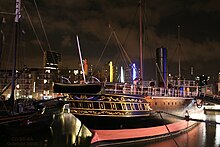
- Railz Miniworld - Model Railway Exhibition
- Wereldmuseum - Völkerkundemuseum
- Natuurhistorisch Museum Rotterdam - collection of around 250,000 natural history objects
- Maritime Museum with the exhibition 'Mainport Live' about the port of Rotterdam
Festivals and events
- International Film Festival Rotterdam , every year in late January and early February
- North Sea Jazz Festival , held annually on the second full weekend in July
- Caribbean summer carnival
- Gergiev Festival - ten-day festival of classical music, held annually in September, under the direction of the Russian conductor Valery Gergiev
- 65th Eurovision Song Contest (probably in May 2021) in the Ahoy Arena , after the actual 65th Eurovision Song Contest from May 12th to 16th, 2020 was canceled due to the COVID-19 pandemic .
education
Compared to the rest of the Netherlands, the residents of Rotterdam have on average a lower level of education. While 26 percent of the population have at least one degree from a university of applied sciences, 34 percent only achieved low levels of education. Migrants in particular usually only have low educational qualifications. More than 60 percent of jobs that require higher education are therefore occupied by commuters from the surrounding communities (especially Capelle aan den IJssel and Spijkenisse ) but also as far as The Hague or Dordrecht .
Rotterdam has a university, the Erasmus University Rotterdam , and several universities of applied sciences. The two most important of these are the Hogeschool Rotterdam and InHolland . Other universities of applied sciences are Pabo Thomas More, Rotterdam Conservatory , Willem de Kooning Academie (art academy), Academie van Bouwkunst. The Technical University in neighboring Delft has close ties to Rotterdam. In 2005, 20,545 students studied at nine different faculties at the Erasmus Universiteit Rotterdam . The largest faculties were economics with over 10,000 students, law with 4,000 students, and medicine with 1,700 students. In the field of medicine, the university conducts top research worldwide in several areas (virology, cell biology); the university's management school is considered one of the best in Europe.
The Rotterdam University of Applied Sciences (Hogeschool Rotterdam) has 23,953 students. The Hogeschool has a regional focus and focuses on mechanical engineering, medicine, urban development and architecture. InHolland is part of a nationwide network of universities of applied sciences and thus offers a much wider range of courses.
Sports
Football is the most important sport in the city. With Feyenoord Rotterdam , Excelsior Rotterdam and Sparta Rotterdam , it has three clubs in the Eredivisie , the highest Dutch football league. Sparta plays its home games in the Het Kasteel stadium ("The Castle").
Feyenoord is one of the traditional big three in Dutch football , along with Ajax Amsterdam and PSV Eindhoven . The club won the European Champion Clubs' Cup in 1970 and the UEFA Cup in 1974 and 2002 . The club was fourteen times Dutch national champion. In the last few years, however, the club remained unsuccessful and constantly ended up outside the top 3 of the table. The club, which comes from the Feijenoord district, plays in De Kuip (officially Feijenoord Stadium ) the second largest stadium in the country and the venue for the 2000 European Championship finals . Sparta Rotterdam was the Dutch champion in 1959 (and five times before the war) and plays in the Delfshaven district. Today Sparta Rotterdam has developed into a "gray mouse" in the second division due to a modest budget. It is the same with Excelsior Rotterdam , which was an elevator team between the first and second division for many years and trained the offspring of Feyenoord for years. Excelsior plays in the small Van Donge & De Roo stadium , which only has 3500 seats.
The largest hockey club in the Netherlands can be found in Rotterdam . The HC Rotterdam has nearly 2,400 members. Both the first men's and women's teams play in the top division.
The route of the Rotterdam Marathon is one of the fastest in the world. The world's best marathon time from 1985 to 1998 was run in Rotterdam: Carlos Lopes held it from 1985 to 1988 before Belayneh Dinsamo replaced him with his 1988 time, which was valid until 1998. A world record was also set at the Rotterdam Half Marathon , which took place from 2004 to 2009, namely in 2005 by Samuel Kamau Wanjiru .
politics
Municipal council
The Rotterdam City Council has had 45 mandates for several decades. The local elections on March 21, 2018 resulted in the following distribution of seats:
| Political party | Seats | |||||
|---|---|---|---|---|---|---|
| 1998 | 2002 | 2006 | 2010 | 2014 | 2018 | |
| Leefbaar Rotterdam | - | 17th | 14th | 14th | 14th | 11 |
| VVD | 9 | 4th | 3 | 4th | 3 | 5 |
| D66 | 3 | 2 | 1 | 4th | 6th | 5 |
| GroenLinks | 4th | 3 | 2 | 3 | 2 | 5 |
| PvdA | 15th | 11 | 18th | 14th | 8th | 5 |
| THINK | - | - | - | - | - | 4th |
| NIDA | - | - | - | - | 2 | 2 |
| SP | 4th | 1 | 3 | 2 | 5 | 2 |
| CDA | 6th | 5 | 3 | 3 | 3 | 2 |
| PVV | - | - | - | - | - | 1 |
| PvdD | - | - | - | - | 1 | 1 |
| 50PLUS | - | - | - | - | - | 1 |
| ChristenUnie / SGP | - | 1 | 1 | 1 | 1 | 1 |
| City party Rotterdam | 2 | 1 | 0 | - | - | - |
| SGP / GPV / RPF | 1 | - | - | - | - | - |
| Unie55 + | 1 | - | - | - | - | - |
| total | 45 | 45 | 45 | 45 | 45 | 45 |
- ↑ Parties that took part in the election but were unable to obtain a seat on the council will not be considered.
mayor
Ahmed Aboutaleb ( PvdA ) has been the acting mayor of the municipality since January 5th, 2009 . Before that, he worked for two years as State Secretary for the Dutch Ministry of Labor and Social Affairs ( Dutch Ministerie van Sociale Zaken en Werk Genealogieheid ).
College of Mayors and Aldermen
Period 2018–2022
The following ten councilors have been appointed for the period 2018-2022:
| City council | Political party | Business area | Remarks |
|---|---|---|---|
| Bert Wijbenga | VVD | Enforcement, living environment, integration, society | First Vice Mayor |
| Bas Kurvers | VVD | Building, living, energy transition built environment | |
| Adriaan Visser | D66 | Finance, organization, port, big projects | Until February 5, 2019 |
| Said Kasmi | D66 | Education, culture, tourism | |
| Judith Bokhove | GL | Mobility, youth, language | |
| Arno Bonte | GL | Sustainability, air quality, energy transition | |
| Barbara Kathmann | PvdA | Economy, districts, small cores | |
| Richard Moti | PvdA | Work, income, Rotterdam-South | |
| Sven de Langen | CDA | Public health, care, elders, sport | |
| Michiel Grauss | CU - SGP | Poverty reduction, debt approach, informal care |
Period 2014–2018
At that time the community had six councilors:
| City council | Political party | Business area | Remarks |
|---|---|---|---|
| Joost Eerdmans | Leefbaar Rotterdam | Security, enforcement, living environment | |
| Maarten Struijvenberg | Leefbaar Rotterdam | Work, economy | |
| Robert Simons | Leefbaar Rotterdam | Urban development, integration | |
| Pex Langenberg | D66 | Sustainability, mobility, port, administration, organization | Until February 22, 2018 |
| Adriaan Visser | D66 | Finance, culture, sport | |
| Sven de Langen | CDA | Education, youth, care |
Community Secretary
The office of community secretary has been exercised by Vincent Roozen since October 10, 2018.
Twin cities
The city of Rotterdam distinguishes between partner and sister cities . There are also closer relationships with sister port cities. In 2008/09 it was decided that the partner and sister cities would not have priority in international relations and that these should instead be intensified with fewer cities.
|
Twin cities
|
Sister cities
|
Sister ports
|
Former twin cities
-
 Istanbul , Turkey from 2005 to March 15, 2017, unilaterally terminated by the Istanbul city administration.
Istanbul , Turkey from 2005 to March 15, 2017, unilaterally terminated by the Istanbul city administration.
Personalities
literature
- Ingrid Ostermann: Reconstruction Rotterdam - metamorphoses of a city . Darmstadt University of Technology. FB Architecture, 2004.
- Eric van Hooydonk, Patrick Verhoeven: The Ports Portable - Antwerp, Hamburg & Rotterdam . Pandora Publishers, Antwerp, ISBN 90-5325-250-9 .
Web links
- Website of the municipality (Dutch)
- Willem de Kooning Academie website (Dutch)
- Rotterdam tiles (German)
- Rotterdam 1900/1940 - Photo Flickr
Individual evidence
- ↑ Bevolkingsontwikkeling; regio per maand . In: StatLine . Centraal Bureau voor de Statistiek (Dutch)
- ↑ [1]
- ^ A b c d Robert E. Dickson: The West European City. A Geographical Interpretation . Routledge 2003, ISBN 0-415-17830-4 , p. 171.
- ↑ a b Willem Frijhoff and Marijke Spies: Dutch Culture in a European Perspective . Uitgeverij van Gorcum 2004, ISBN 90-232-3965-2 , p. 114.
- ↑ a b Willem Frijhoff and Marijke Spies: Dutch Culture in a European Perspective . Uitgeverij van Gorcum 2004, ISBN 90-232-3965-2 , p. 116.
- ↑ Ostermann, p. 10 ff.
- ^ A b Leo van den Berg: European Cities in the Knowledge Economy. Ashgate Publishing 2005, ISBN 0-7546-4521-5 , p. 256.
- ^ Leo van den Berg: European Cities in the Knowledge Economy . Ashgate Publishing 2005, ISBN 0-7546-4521-5 , p. 271.
- ↑ Ostermann, p. 8.
- ^ Jan Rath: Western Europe and Its Islam . Brill 2001, ISBN 90-04-12192-7 , p. 112.
- ↑ Gemeente Rotterdam: Onderzoek 010 Population. Accessed July 30, 2020 .
- ^ Leo van den Berg: European Cities in the Knowledge Economy . Ashgate Publishing 2005, ISBN 0-7546-4521-5 , p. 265
- ^ Leo van den Berg: European Cities in the Knowledge Economy . Ashgate Publishing 2005, ISBN 0-7546-4521-5 , pp. 256, 271
- ↑ a b c d Leo van den Berg: European Cities in the Knowledge Economy . Ashgate Publishing 2005, ISBN 0-7546-4521-5 , p. 263
- ^ Ans Kolk, Mark van der Veen: Dilemmas of Balancing Organizational and Public Interests: How Environment Affects Strategy in Dutch Main Ports . In: European Management Journal, Vol. 20 (2002), No. 1, pp. 45-54
- ↑ http://orf.at/#/stories/2130497/ The Netherlands are now 2000 hectares larger, ORF.at from July 11, 2012
- ↑ webmaster: EuroVelo 15: from the source of the Rhine to the North Sea - EuroVelo. Retrieved May 15, 2017 .
- ↑ 55 million passengers traveled via Schiphol in 2014. Regional airports report significant growth figures. In: press release. Schiphol Group, accessed on September 4, 2015 .
- ↑ The Ataturk Airport overhauled in 2014 with 57 million passengers for the first time Schiphol
- ↑ a b c City portrait at the Delta Works ( Memento of the original from October 26, 2007 in the Internet Archive ) Info: The archive link was inserted automatically and has not yet been checked. Please check the original and archive link according to the instructions and then remove this notice. .
- ↑ Willem Frijhoff and Marijke Spies: Dutch Culture in a European Perspective. Uitgeverij van Gorcum 2004, ISBN 90-232-3965-2 , p. 115.
- ^ Van Hooydonk, Verhoeven, pp. 341f.
- ^ Leo van den Berg: European Cities in the Knowledge Economy . Ashgate Publishing 2005, ISBN 0-7546-4521-5 , p. 262.
- ↑ Result of the local elections: 2014 2018 , accessed on June 9, 2018 (Dutch)
- ↑ Allocation of seats in the municipal council: 1998–2002 2006 2010 2014 2018 , accessed on June 9, 2018 (Dutch)
- ^ Aboutaleb nieuwe burgemeester Rotterdam. In: de Volkskrant . De Persgroep Nederland , January 5, 2009, accessed June 9, 2018 (Dutch).
- ↑ College van Burgemeester en Wethouders , Gemeente Rotterdam, accessed on February 11, 2019 (Dutch)
- ↑ AD : Wethouder Visser serves ontslag in. Retrieved on February 11, 2019 (Dutch).
- ↑ College Rotterdam compleet , NOS , May 12, 2014 (Dutch)
- ^ AD : Wethouder Pex Langenberg treedt af om Hoekse Lijn-debacle. Retrieved February 11, 2019 (Dutch).
- ↑ Gemeentesecretaris Vincent Roozen , Gemeente Rotterdam , accessed on February 8, 2019 (Dutch)
- ↑ "Rotterdam is shifting from traditional town twinning to more concentrated partnership activity ... a selection of four partnership cities would be recommendable." "Rotterdam Wereldstad: Vaste koers, nieuwe ambitities" Gemeente Rotterdam, 2009, p. 33 (PDF; 2 , 1 MB)
- ↑ Erdogan is still looking for a confrontation with The Hague. AFP , accessed March 15, 2017 .

